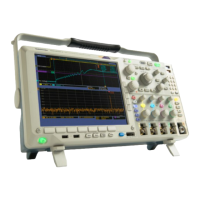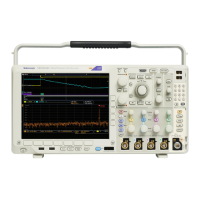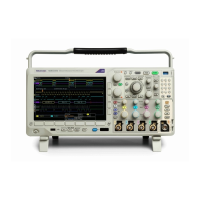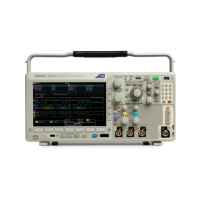Performance Ve ri fi cation
h. Change the freq
uency range as follows:
Change the stop frequency to 9.2 MHz.
Change the start frequency to 980 kHz.
i. Set the generator to provide a 1 MHz, –15 dBm signal.
j. Step the generator, in 1 MHz intervals, through frequencies from 1 MHz
to9MHz. Ateachinterval,determine the test result as follows:
Note the reading on the power meter and the readout for the Reference
marker on the oscilloscope.
Calculate the difference between the two readings. This is the test
result.
k. In the test record, enter the greatest result determined within this frequency
range (1 MHz to 9 MHz).
l. Change the frequency range as follows:
Change the stop frequency to 92 MHz.
Change the start frequency to 9.8 MHz.
m. Set the generator to provide a 10 MHz, –15 dBm signal.
n. Step the generator, in 10 MHz intervals, through frequencies from 10 MHz
to 90 MHz. At each interval, determine the test result as follows:
Note the reading on the power meter and the readout for the Reference
marker on the oscilloscope.
Calculate the difference between the two readings. This is the test
result.
o. In the test record, enter the greatest result determined within this frequency
range(10MHzto90MHz).
p. For MDO4104-3, MDO4054-3, MDO4034-3 and MDO4014-3 Only.
Change the frequency range as follows:
Change the stop frequency to 3.1 GHz.
Change the start frequency to 99 MHz.
q. Set the generator to provide a 100 MHz, –15 dBm signal.
r. Step the generator, in 100 MHz intervals, through frequencies from
100 MHz to 2.9 GHz. At each interval, determine the test result as follows:
Note the reading on the power meter and the readout for the Reference
marker on the oscilloscope.
Calculate the difference between the two readings. This is the test
result.
MDO4000 Series Specifications and Performance Verification 99

